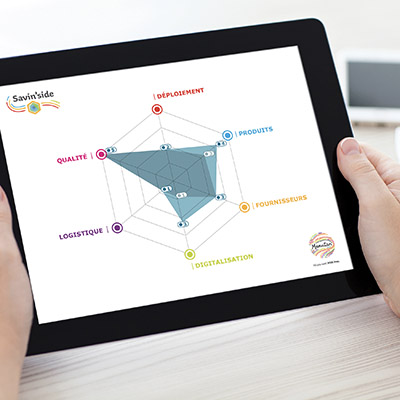To address climate change, economic actors are taking action, with the flagship goal of the Paris Agreement in mind: Achieving net-zero emissions by 2050. In this context, TCO2, or tonne of CO2 equivalent, emerges as an essential tool for evaluating carbon footprint. As procurement departments have a major role to play in their organisation’s decarbonisation strategy, they would benefit from becoming familiar with this indicator.
What is the tonne of co2 equivalent (TCO2)?
The TCO2, or tonne of CO2 equivalent, is a measurement unit used to evaluate the impact of different greenhouse gases on the environment and to cumulate their emissions. This indicator allows different types of greenhouse gases to be converted into a single unit, the CO2 equivalent. We find this indicator under various terminologies: CO2 equivalent, TCO2, tCO2eq., eq CO2, COeq, eq. CO2, CO2e…
Why focus on CO2?
Today, carbon dioxide (CO2) is the main greenhouse gas considered responsible for climate change. This is due to its high concentration in the atmosphere, its origin being mainly linked to human activities, its major impact on the greenhouse effect, and its long lifespan in the atmosphere. For all these reasons, CO2 has become a reference value in the fight against the climate crisis.
A reference indicator
The carbon dioxide equivalent was created by the IPCC (Intergovernmental Panel on Climate Change) to compare greenhouse gas emissions according to their "global warming potential". This is the warming power of a greenhouse gas, depending on the duration for which it remains active in the atmosphere. Because carbon dioxide is defined as the reference gas, its global warming potential (GWP) is set at 1.
Each greenhouse gas has its own lifespan and global warming potential, which allows its CO2 equivalent to be obtained. For example, methane has a global warming potential 25 times higher than CO2 over a 100-year period. Thus, one tonne of methane is equivalent to 25 tonnes of CO2 in a greenhouse gas emissions inventory.
In summary, the tonne of CO2 equivalent simplifies comparisons, analyses, and communication of various greenhouse gases’ impacts. This allows a clear carbon footprint to be established at the level of countries, organisations, or even individuals.
As a reminder, six greenhouse gases are monitored under the Kyoto Protocol:
- Carbon dioxide (CO2): Combustion of fossil fuels, livestock and intensive agriculture, deforestation…
- Methane (CH4): Cattle farming, exploitation of rivers and landfills…
- Nitrous oxide (N2O): Refrigeration and automotive industries, excess fertilisers spread on fields…
- Hydrofluorocarbons (HFCs): Air conditioning and refrigeration systems…
- Perfluorocarbons (PFCs): Air conditioning and refrigeration systems, fire extinguishers…
- Sulphur hexafluoride (SF6): Electrical equipment and semiconductors…
Calculating the carbon footprint
The starting point for fighting climate change is calculating your carbon footprint. To do this, you need to identify the main greenhouse gases involved in the activity you want to evaluate, and then translate them into their carbon dioxide equivalent.
If you follow the carbon footprint method, the calculation is then based on emission factors. This corresponds to the average emission rate of a given source, linked to the activity concerned.
There are two main emission factors:
- The physical emission factor corresponds to the amount of CO2 emitted per unit consumed. For example, a ferry trip emits an average of 5 kg of CO2 (emission factor) per km (quantity consumed).
In this case, CO2 equivalent emissions = quantity consumed X physical emission factor
- The monetary emission factor expresses the amount of CO2 for a product and/or service based on its price. For example, a chocolate bar emits an average of 0.253 kg of CO2 (emission factor) per euro (price).
Here, CO2 equivalent emissions = price X monetary emission factor
In short, this emission factor is used to convert data from an activity, product and/or service into greenhouse gas emissions. Some international organisations (GHG Protocol, ADEME, DEFRA…) have built databases with default emission factors. However, it is always preferable to use specific emission factors for greater accuracy.
TCO2: How to integrate it into procurement?
Within organisations, procurement departments have a prime position to reduce their scope 3 emissions. As a reminder, these are all indirect greenhouse gas emissions generated in companies’ value chains. Different categories are included: Purchases of products and services, upstream and downstream transportation and distribution, transformation of products sold…
To reduce their carbon footprint, procurement departments must identify all emission categories. For each one, they then need to collect activity data (fuel consumption, tonne/km transported…) and apply emission factors to convert them into a quantity of greenhouse gases, which will be expressed in CO2 equivalents.
This analysis allows procurement departments to identify the categories that account for the majority of emissions. These are often purchases of products and services, upstream and downstream transportation… From these results, buyers can identify priority areas for carbon reduction and implement actions, setting clear objectives. For example, they may decide to favour eco-responsible products, optimise logistics, or manage the service rate…
As you can see, integrating the carbon dioxide equivalent is essential in any decarbonisation approach. By evaluating and reducing their carbon footprint with this tool, companies can reinvent their procurement strategies in favour of eco-innovation, more responsible suppliers, and more sustainable products and services. In the future, this will allow them to comply with regulations, differentiate themselves in their market and ensure their long-term development.









